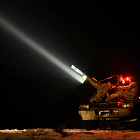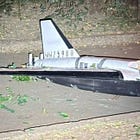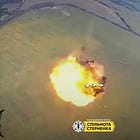Key points:
What goes up must come down. Intercepting a Shahed-136/Geran-2/Garpiya strike drone results in debris plummeting uncontrollably toward the planet’s surface with what amounts to a random point of impact.
Different anti-aircraft capabilities and anti-aircraft munitions result in damage that varies in terms of both kind and degree. Lower-cost anti-aircraft capabilities and anti-aircraft munitions are likely to result in damaged, not destroyed, aircraft that will crash in a more or less intact state—possibly with an intact warhead—into the planet’s surface. When low-cost anti-aircraft capabilities and anti-aircraft munitions are used in or near residential areas, the successfully intercepted strike drone will still pose a serious threat, with the added complications that no one knows the ultimate point of impact, and no one, including the military that launched the strike drone, can do anything about it.
Cost and availability are not the only factors at play when determining air defence requirements and other military requirements more generally. All else being equal, lower cost generally translates into lower capability for good reason. In the area of air defence capabilities, lower cost can also translate into assuming more risk in sustaining—absorbing—damage, including damage at points of impact that were not the intended target of the successfully intercepted strike munition.
It should come as no surprise that what goes up must come down, not least on a planet in which gravity accelerates objects to the ground at a rate of 9.8 m/s². This dynamic, of course, includes the likes of Russia’s propeller-driven fixed-wing Shahed-136/Geran-2/Garpiya strike drones, which are not only being launched against Ukraine in ever-increasing numbers but are also being intercepted by Ukraine through an increasingly diverse and heterogeneous set of air defence capability set. While the question of how many strike drones Russia launches and how many strike drones Ukraine intercepts dominates headlines and many analytical writings, the question of how Ukraine intercepts Russian strike drones receives very little attention, even though this is where most of the consequential analytical implications lie. In this post, I will focus on what happens when a Shahed-136/Geran-2/Garpiya—and other strike munitions, Russian or otherwise, more generally—are shot down. None of the attached videos feature graphic context—this post does not directly examine the effects at the ultimate point of impact with the planet’s surface.
The above video is reported to have been recently recorded in the Ukrainian city of Dnipro. The video records a Russian Shahed-136/Geran-2/Garpiya strike drone that has (A) been damaged by some Ukrainian air defence capability—the Russian strike drone is clearly on fire and may have had a lot of fuel remaining, given how relatively proximate Dnipro is to the frontlines/international border—and is (B) plumetting uncontrollably to the ground with the end result of impacting at what is essentially a random part of the planet’s surface, one that happens to be in the Dnipro metropolitan area in this instance.
There are many such videos of strike drone interceptions from the Russia-Ukraine War, a conflict that is, of course, taking place at a time and in a context characterized by the widespread availability of camera-equipped mobile phones and internet access. The following video was posted on social media in July 2025 and shows much the same dynamic.
These two videos serve as a reminder that successful interceptions of strike munitions will result in debris plummeting uncontrollably to the planet’s surface in what is, for all practical intents and purposes, a random and unpredictable way. While only an act of god can change the ultimate points on the ground that the debris from what was a functioning strike drone will impact, different types of air defence capabilities will generate different types of debris.
Different Anti-Aircraft Capabilities, Different Effects On The Targeted Object
When assault rifles and machine guns of the light and medium variety are used to shoot down strike drones and other flying objects, the projectiles that are fired—bullets—create fairly small holes in the target object. While small arms can be used to intercept the likes of Shahed-136/Geran-2/Garpiya strike drones, the bullets have limited incendiary effects and do not contain any explosive material—the effects on the strike drone being targeted are almost entirely kinetic in nature. As a result, unless a lucky bullet initiates the detonation of the warhead installed in the strike drone, a successful interception involving the use of assault rifles and machine guns of the light and medium variety will, at best, result in a damaged strike drone that will at some point no longer fly as intended along the preprogrammed flight path and will, like all flying objects, crash into the planet’s surface. The impact point is, in effect, random and unpredictable, and the strike drone’s warhead may or may not still detonate upon impact with the planet’s surface.
When heavy machine guns and, more to the point, autocannons are used to shoot down strike drones and other flying objects, the projectiles that are fired will either only have kinetic effects or, more commonly in an air defence context, will contain incendiary material and/or explosives—explosives are generally found in autocannon ammunition (i.e., 20 mm and larger). The use of heavy machine guns and autocannons in particular will subject the likes of Shahed-136/Geran-2/Garpiya strike drones to significant structural damage. With incendiary material being commonly used with both heavy machine gun and autocannon ammunition, the targeted object may catch fire, not least when the fuel tank(s) are hit. Even so, unless a lucky hit initiates the detonation of the warhead installed in the strike drone, a successful interception involving the use of heavy machine guns and autocannons will typically result in a damaged strike drone that will, at some point, no longer fly as intended along the preprogrammed flight path and will, like all flying objects, crash into the planet’s surface. The impact point is, in effect, random and unpredictable, and the strike drone’s warhead may or may not still detonate upon impact with the planet’s surface.
A note on the combustibility of fuel and range-payload: This post deals with the interception of powered strike munitions that, by definition, either carry fuel onboard or are electrically powered. While electrically-powered strike drones exist, these are severely limited in terms of range-payload given the poor energy density and specific energy of even the latest lithium-ion batteries relative to petroleum-based fuels. Russia’s Lancet (Izdeliye-51) loitering strike drone, for example, is being used to attack targets located a hundred or so kilometers away, but is equipped with a very small/light warhead that is unsuitable for the roles in which the Shahed-136/Geran-2/Garpiya strike drone design is employed. The Shahed-136/Geran-2/Garpiya is, in its baseline configuration, reportedly capable of carrying a 50-kilogram warhead over a distance of 2000 kilometers. As I’ve explained in many posts dealing with this Iranian-origin strike drone design in Russian service, this range-payload is poorly optimized for Russia’s purposes in the specific military-geographic context of the Russia-Ukraine War, and an unknown percentage of the Shahed-136/Geran-2/Garpiya strike drones launched against Ukraine are equipped with a heavier 90-kilogram warhead in a reduced range configuration.
Given the above, this post primarily covers the interception of strike drone designs that are not equipped with electric propulsion. The Shahed-136/Geran-2/Garpiya is powered by a piston engine that combusts gasoline. Some uncrewed aircraft—but seemingly no (single-use) strike drones used in the Russia-Ukraine War—are equipped with aero diesel engines and, as such, combust a “heavy fuel” in the form of diesel. Some uncrewed aircraft—but seemingly no (single-use) strike drones used in the Russia-Ukraine WAr—are equipped with turboprop engines that combust a kerosene-based jet fuel. Gasoline is flammable, whereas diesel fuel and kerosene-based jet fuels are combustible. Strike drone designs equipped with piston engines, such as the Shahed-136/Geran-2/Garpiya, therefore, have an inherent vulnerability that can be taken advantage of. This is not a dynamic unique to intercepting strike drones—the damage that a munition can inflict on a tank, aircraft, and warship tends to be greatly amplified by the presence of onboard fuel and munitions that result in the secondary effects of the warhead/destructive payload of a munition.
When it comes to autocannon ammunition, it bears emphasis that we are dealing with a highly heterogeneous grouping of armaments that can employ a diverse array of ammunition. Some types of autocannon ammunition, namely those that feature either proximity fuses or programmable airburst fuses, can result in significantly more damage through fragmentation effects—a greater number of smaller and lighter high-velocity kinetic impacts on the targeted strike drone. The largest caliber autocannons, however, typically employ ammunition that features a significant amount of explosive material. While such autocannons have a lower rate of fire, hits, whether direct or the result of a non-impact fuse, can severely damage, if not functionally destroy, a strike drone such as the Shahed-136/Geran-2/Garpiya. Even so, the use of autocannons of any type is likely to result in large chunks of debris, including a possible intact warhead, crashing into the planet’s surface at what amounts to a random location.
When surface-to-air and air-to-air missiles are used to shoot down strike drones and other flying objects, the missiles will generally carry a substantial amount of high explosives that is measured in kilograms. For shoulder-launched surface-to-air missiles, we are dealing with a warhead that typically weighs around one kilogram. All else being equal, as (most) surface-to-air and air-to-air missiles become larger and offer greater range, the installed warheads tend to become larger and heavier. For shorter-range surface-to-air missiles and most air-to-air missiles, a warhead of around 10 kilograms is commonplace. Anti-aircraft missiles of the so-called hit-to-kill variety—which have kinetic effects—may contain no high explosives at all, but some designs feature a small warhead as a so-called lethality enhancer. Many medium-range surface-to-air missiles feature a warhead that weighs something in the region of 50 kilograms while long-range surface-to-air missiles may have warheads that may weigh something in the region of 100 kilograms. Simply stated, surface-to-air and air-to-air missiles have very different effects on the likes of a Shahed-136/Geran-2/Garpiya strike drone than small arms and light/medium machine guns or even heavy machine guns and autocannons.
Whereas the use of small arms as well as heavy machine guns and autocannons will generally result in a strike drone eventually crashing uncontrollably in a more or less intact state into the planet’s surface in what amounts to a random location, surface-to-air and air-to-air missiles will generally result in severe damage to, if not the outright destruction of, the likes of a Shahed-136/Geran-2/Garpiya strike drone. In part, this is because strike drones are of fairly fragile construction and can be severely damaged—functionally destroyed—when subject to a nearby detonation of a significant amount of high explosives, subject to a large number of high-velocity fragments from the nearby detonation of an anti-aircraft missile’s warhead, or when subject to a direct hit by a quite heavy high-speed anti-aircraft missile. The above video is understood to have been recently recorded in southern Israel and captures the interception of a propeller-driven fixed-wing strike drone of Iranian origin launched by Ansarallah in Yemen against Israel. This video is particularly notable in that it not only documents the successful interception of a propeller-driven fixed-wing strike drone with a missile but also captures two explosions, the second of which results in what appears to have been quite small pieces of debris crashing into the planet’s surface.
The Problem With Interceptor Drones
In an ideal world, Ukraine and other countries would use as many anti-aircraft missiles—with associated launchers, sensors, and support equipment—as needed to secure their airspace. Resources are, however, limited, and anti-aircraft missiles—just the single-use anti-aircraft missiles without the reusable supporting equipment—are very expensive, not least when compared to a target like the Shahed-136/Geran-2/Garpiya strike drone design. Ukraine, therefore, extensively relies on small arms, machine guns, and autocannons, which are quite inexpensive and plentiful—in terms of both the reusable firearm and its ammunition—for rear area air defence against propeller-driven fixed-wing strike drones in particular.
It is worth noting that this is an inexpensive but extremely manpower intensive approach to air defence, and one that is not suitable for use against all target types. To enhance the effectiveness of this approach to air defence against the likes of the Shahed-136/Geran-2/Garpiya strike drones employed by Russia, Ukraine has equipped its machine gun- and/or autocannon-equipped machine gun teams with the likes of infrared and thermal sights, mobile short-range high-frequency acquisition radars, and both early warning and a form of tracking through a nationwide acoustic sensor network, among other measures. While all of these efforts have sustained a remarkably effective nationwide air defence capability set—remarkable largely as a result of what it is/is not, with the caveat that Russia’s employment of its strike drones and other strike munitions more generally has been remarkably unimaginative and, as such, unsurprisingly ineffectual—the ammunition used with Ukraine’s small arms, machine guns, and autocannons has the same limitations as before and, most of the time, results in damaged strike drones that will crash into the planet’s surface with an intact warhead.
The following recently publicized video compilation documenting the activity of a Russian rear-area air defence team—which can be seen operating in much the same manner as its Ukrainian counterparts—constitutes a case in point. Note that the warheads installed in the Ukrainian AN-196 propeller-driven fixed-wing strike drones only detonated after the severely damaged low-flying strike drones crashed into the planet’s surface, at what amounted to a random point of impact. If this video had been recorded in a built-up area such as a large city, the Ukrainian strike drones may have detonated upon impact with or near residential buildings.
Ukraine is far too large a country for rudimentary anti-aircraft artillery to be in all places at all times and, more generally, has a long list of limitations, including limited destructive effects on successfully intercepted strike drones like the Shahed-136/Geran-2/Garpiya. Ukraine has, therefore, developed what amount to lower-cost, slower, and, in essentially every respect, lower-capability anti-aircraft munitions that can be likened to propeller-/rotor-driven anti-aircraft missile surrogates. I have covered some of these developments in several recent posts:
Ukraine is now using interceptor drones of both the multirotor and the fixed-wing variety in ever-increasing numbers to intercept Russia’s propeller-driven fixed-wing strike drones. While these vary in design and function, the heterogeneous details are not very consequential for the present purposes. In order to optimize on high speed and low cost—all without using a solid propellant rocket motor—Ukraine’s interceptor drones have a very limited payload, which is to say that armed interceptor drones are unlikely to be equipped with a warhead that weighs much more than a kilogram or so—at most, just several kilograms. This is particularly the case with Ukraine’s multirotor interceptor drones. It bears emphasis that most, if not all, of Ukraine’s interceptor drones of both the fixed-wing and multirotor variety are electrically powered. Many factors are likely to have led to this design choice, above all the interrelated imperatives of developing an interceptor drone design that not only flies faster than the target object but has a very significant advantage in terms of acceleration so as to close the distance to the target strike drone before it leaves the limited maximum range-endurance of the electrically-powered interceptor drone that is reliant on batteries. Given these dynamics, some of Ukraine’s interceptor drones, particularly those of the multirotor variety, are unarmed, kinetic effect only, uncrewed aircraft turned anti-aircraft munitions. The videos showing interception attempts against Russia’s (seemingly primarily) unarmed Gerbera decoy drones are a case in point.
One of the implications of Ukraine’s turn toward interceptor drones of both the fixed-wing and multirotor variety is that successful interceptions are likely to result in a damaged Shahed-136/Geran-2/Garpiya that will eventually crash into the planet’s surface at what amounts to a random location—as seen in the first two videos in this post. Should the warhead remain intact, it may detonate upon impact with the ground. The successful Russian interceptions of Ukrainian AN-196 propeller-driven fixed-wing strike drones in one of the above videos should illustrate how such dynamics can play out. Simply stated, these inexpensive approaches to air defence are best deployed in areas that the likes of the Shahed-136/Geran-2/Garpiya are expected to overfly while transiting toward their intended targets. Unless interceptor drones are equipped with a sizable high explosive warhead, successful interceptions are likely to result in a more or less intact airframe—possibly including an intact warhead—plummeting uncontrollably into the planet’s surface with what amounts to a random point of impact. While this is likely to be perfectly acceptable when the random point of impact is in an agricultural area or other sparsely populated area, this is unlikely to be the case when the random point of impact is in a residential area.
As with all areas of military technology, Ukraine and any other countries interested in interceptor drones of the fixed-wing and/or multirotor variety to counter the likes of the Shahed-136/Geran-2/Garpiya strike drone encounter tradeoffs. Different anti-aircraft capabilities and anti-aircraft munitions result in damage that varies in terms of both kind and degree. Countries that turn toward lower-cost anti-aircraft capabilities must assume the risk that strike drones and similar targets are likely to crash in a more or less intact state, possibly with an intact warhead. Given all of this, cost and availability should not be the only factors at play when determining air defence requirements and other military requirements more generally.





